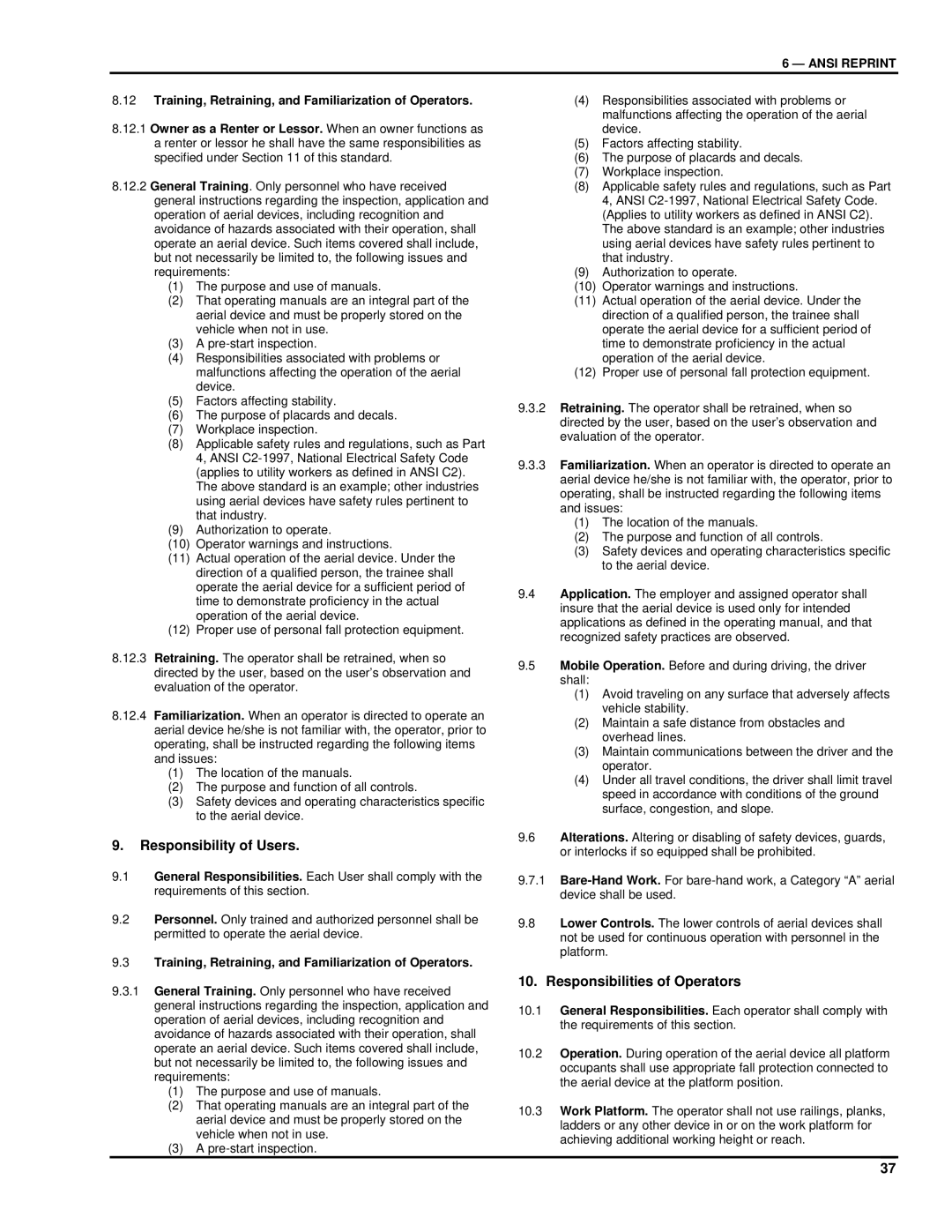
6 — ANSI REPRINT
8.12Training, Retraining, and Familiarization of Operators.
8.12.1Owner as a Renter or Lessor. When an owner functions as a renter or lessor he shall have the same responsibilities as specified under Section 11 of this standard.
8.12.2General Training. Only personnel who have received general instructions regarding the inspection, application and operation of aerial devices, including recognition and avoidance of hazards associated with their operation, shall operate an aerial device. Such items covered shall include, but not necessarily be limited to, the following issues and requirements:
(1)The purpose and use of manuals.
(2)That operating manuals are an integral part of the aerial device and must be properly stored on the vehicle when not in use.
(3)A
(4)Responsibilities associated with problems or malfunctions affecting the operation of the aerial device.
(5)Factors affecting stability.
(6)The purpose of placards and decals.
(7)Workplace inspection.
(8)Applicable safety rules and regulations, such as Part 4, ANSI
(9)Authorization to operate.
(10)Operator warnings and instructions.
(11)Actual operation of the aerial device. Under the direction of a qualified person, the trainee shall operate the aerial device for a sufficient period of time to demonstrate proficiency in the actual operation of the aerial device.
(12)Proper use of personal fall protection equipment.
8.12.3Retraining. The operator shall be retrained, when so directed by the user, based on the user’s observation and evaluation of the operator.
8.12.4Familiarization. When an operator is directed to operate an aerial device he/she is not familiar with, the operator, prior to operating, shall be instructed regarding the following items and issues:
(1)The location of the manuals.
(2)The purpose and function of all controls.
(3)Safety devices and operating characteristics specific to the aerial device.
9.Responsibility of Users.
9.1General Responsibilities. Each User shall comply with the requirements of this section.
9.2Personnel. Only trained and authorized personnel shall be permitted to operate the aerial device.
9.3Training, Retraining, and Familiarization of Operators.
9.3.1General Training. Only personnel who have received general instructions regarding the inspection, application and operation of aerial devices, including recognition and avoidance of hazards associated with their operation, shall operate an aerial device. Such items covered shall include, but not necessarily be limited to, the following issues and requirements:
(1)The purpose and use of manuals.
(2)That operating manuals are an integral part of the aerial device and must be properly stored on the vehicle when not in use.
(3)A
(4)Responsibilities associated with problems or malfunctions affecting the operation of the aerial device.
(5)Factors affecting stability.
(6)The purpose of placards and decals.
(7)Workplace inspection.
(8)Applicable safety rules and regulations, such as Part 4, ANSI
(9)Authorization to operate.
(10)Operator warnings and instructions.
(11)Actual operation of the aerial device. Under the direction of a qualified person, the trainee shall operate the aerial device for a sufficient period of time to demonstrate proficiency in the actual operation of the aerial device.
(12)Proper use of personal fall protection equipment.
9.3.2Retraining. The operator shall be retrained, when so directed by the user, based on the user’s observation and evaluation of the operator.
9.3.3Familiarization. When an operator is directed to operate an aerial device he/she is not familiar with, the operator, prior to operating, shall be instructed regarding the following items and issues:
(1)The location of the manuals.
(2)The purpose and function of all controls.
(3)Safety devices and operating characteristics specific to the aerial device.
9.4Application. The employer and assigned operator shall insure that the aerial device is used only for intended applications as defined in the operating manual, and that recognized safety practices are observed.
9.5Mobile Operation. Before and during driving, the driver shall:
(1)Avoid traveling on any surface that adversely affects vehicle stability.
(2)Maintain a safe distance from obstacles and overhead lines.
(3)Maintain communications between the driver and the operator.
(4)Under all travel conditions, the driver shall limit travel speed in accordance with conditions of the ground surface, congestion, and slope.
9.6Alterations. Altering or disabling of safety devices, guards, or interlocks if so equipped shall be prohibited.
9.7.1
9.8Lower Controls. The lower controls of aerial devices shall not be used for continuous operation with personnel in the platform.
10. Responsibilities of Operators
10.1General Responsibilities. Each operator shall comply with the requirements of this section.
10.2Operation. During operation of the aerial device all platform occupants shall use appropriate fall protection connected to the aerial device at the platform position.
10.3Work Platform. The operator shall not use railings, planks, ladders or any other device in or on the work platform for achieving additional working height or reach.
37
